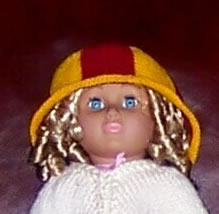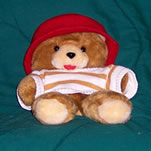
Machine Knit Bucket Hat
 This
knitting fiend web page has a pattern generator (aka program) to create a pattern to help
you knit a bucket hat using any knitting machine. (If you don't own a
knitting machine, you can browse machines available
at All Brands on this list I compiled.)
This
knitting fiend web page has a pattern generator (aka program) to create a pattern to help
you knit a bucket hat using any knitting machine. (If you don't own a
knitting machine, you can browse machines available
at All Brands on this list I compiled.)I made Colocha's hat, pictured below in two colors to illustrate the construction. Shy, retiring humans will likely prefer a single color hat; rowdy ones may want a two color hat in team colors to wear to sports events. (Really rowdy ones may want 8 colors.)
I'm planning to design a hand knit version of the pattern soon; it will be knit from the bottom up. So, it will be difficult to make one just like Colocha's using that construction method. If you are a hand knitter, and you like the way Colocha's hat looks, you can knit a hat sideways as this one is. However, you will need to keep track of rows and stitches. You can do that on paper, but it's helpful to count rows using a knit register, available at Joanne.com. )
Main site, blog (read the latest), hat collection, and Poncho & Cape collection.
Characteristics of the hat: 
- Knit sideways using short rows.
- You may vary the hat size to fit any head, and you may also vary the overall diameter of the hat.
- Has a small flared out brim.
To design your hat you will need to enter your head circumference and tightness factor below. You must also specify the stitch and row gauges.
Have fun knitting and wearing your hat,Lucia
